Becoming a Professional Airshow Pilot- It’s A Long, Hard Road, But Worth Every Step
Throughout each article and interview I’ve read about becoming an airshow pilot, aerobatic champions say there’s one thing you need above all others: an obsessive love of flight. You need to be willing to undertake a decade or more of training, performing, schmoozing with sponsors (if you make it that far), and putting tens of thousands (or more) in debt on your credit card, unless you have an exceptional day job or a very supportive partner. Once you make it past the trials and tribulations of the air show circuit, however, the only way to go is up.
The Thrill of Aerobatics: A Fatal Attraction
“There is a thrill of vulnerability at all airshows. There is no way of making everything completely safe. When the machines are being thrashed to capacity and the pilots are flying at their limits to dazzle, things are bound to go wrong sometimes. There have been some historic disasters, but the danger is a part of the attraction.” Alex James
Regardless of age or flight experience, many pilots can remember attending their first airshow. Laying out a beach towel on the grass or bleachers and looking up into the sky with your family, soaking in the roar of the engines and smell of gasoline while you’re transfixed on the colorful smoke and aerobatic maneuvers completed by brightly colored airplanes high in the air is an experience everyone, not just pilots should have. Nothing is as life-affirming as seeing a high-powered airplane tumbling through the air like a model rocket about crowds of hundreds of thousands of ooh-ing and aw-ing spectators than knowing that there is a human pilot inside that airplane who gets much of a thrill out of risking their life as the spectators do on the ground.
And when I say “risking their life,” I don’t mean it casually. These pilots can spend hundreds of hours practicing and choreographing their routines before the flashing cameras of spectators even catch a glimpse. But regardless of all that training and experience, there has been at least one airshow pilot casualty nearly every year since 1910. Last year, world champion Red Bull stunt pilot Michel Leusch died in front of hundreds of onlookers after losing control of his plane, bringing an all-too-real reminder to pilots that yes, it can happen to you. Despite (or maybe because of) the inherent risk of pushing aerobatic planes- and their pilots- to the absolute physical limit, the life of an airshow pilot holds a glamorous allure that belies the tremendous amount of behind-the-scenes work it takes to make it to the top.
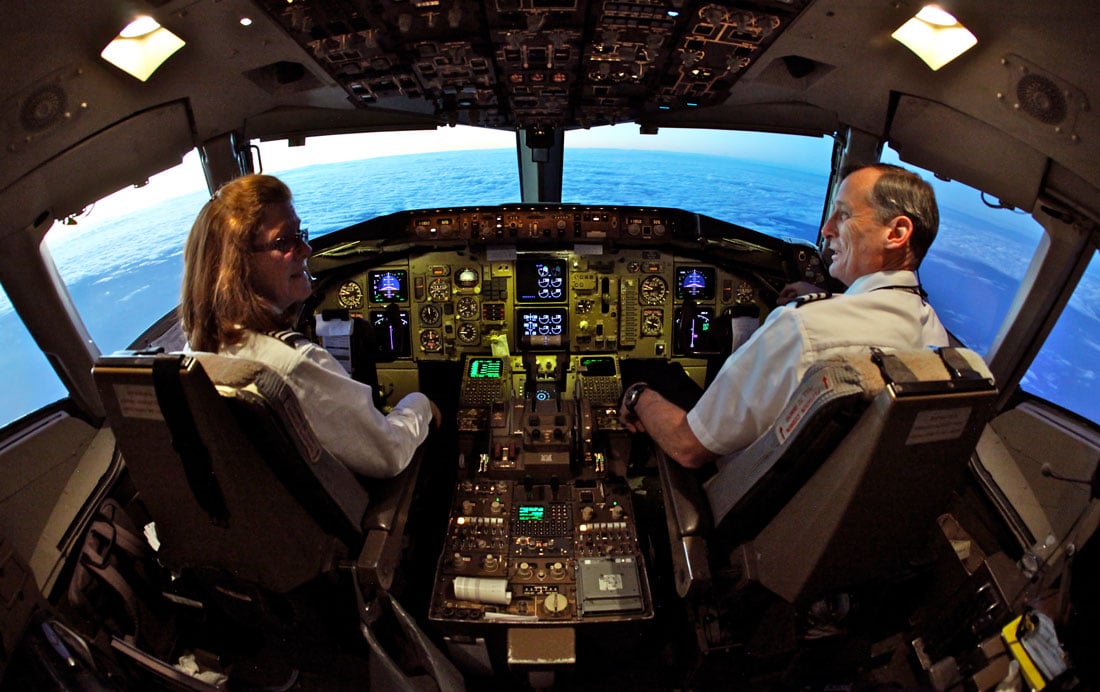 Do Men or Women Make Better Pilots?
Do Men or Women Make Better Pilots?
I wasn’t searching for the answer because I really didn’t think there was one. I discovered it by chance one day when I was a first officer on a B727-200. Because I witnessed the answer with my own eyes, I accidentally became a better pilot. The answer is quite simple: men and women are different. Shocking, I know, but the question to the answer is: who are better pilots, men or women? [Read More]
Basic Steps Towards Becoming an Airshow Pilot, and the Cost
The following 10-step guide is the best-case scenario for someone just starting out, and doesn’t include the dozens of half-steps and knockdowns most aerobatic champions take on their way to the top, including personal life and financial setbacks, crashes, inability to find sponsors, inability to find time to practice, traveling for airshows, applying for scholarships, and spending countless hours choreographing the subtle nuances of an airshow routine within the strictly enforced confines of your ACE-determined “box,” which then includes music, smoke (if you choose), and trying to innovate and design moves never-before-seen to make a name for yourself as a future aerobatic champion. Oh, and as National Aerobatic Champion Patty Wagstaff describes, lots and lots of paperwork4.
If, after that, you’re still interested in learning to become an airshow performer, dive in! Perseverance is the name of this game.
(All listed prices are including aircraft rental and dual instruction and based off prices listed online5; price will be significantly lower if you own your own aerobatic airplane, or are part of a flying club.)
- Private Pilot Certificate: Minimum 40 total hours, approximately $10,000.
- Commercial License: Minimum 250 total hours, approximately $6,500-7,000
- Aerobatic School: Around 40+ hours, approximately $8,100
- Emergency maneuver training course: About 10 hours, approximately $1,400.
- Tailwheel endorsement: About 6-8 hours dual instruction, approximately $1,400.
- Basic Aerobatic Course: About 10 total hours, approximately $1,800.
- High-performance endorsement: Between 5-10 hours, approximately $2,000.
- Complex endorsement (Optional, depends on the aircraft you want to fly): Between 5-10 hours, approximately $1,500
- ACE (Aerobatic Competency Evaluation)7
- Join ICAS (International Council of Airshows) (You must be a member to join the ACE program: $325/yr), and IAC+EAA (You must be a member to compete in airshows: $55-85/yr for both)
- Find a qualified ACE (Aerobatic Competency Evaluator) to recommend you and decide performance levels.
- Written application, renewed every 2 years by an ACE.
- Choreograph your routine (and practice!)
- Amateur contests/competitions6
- Fly at small-town shows and such (county fairs, whatever, to get your name out there)
- Get sponsors!
- Big time contests/competitions.
- Invited to headline at big airshows.
*According to Air & Space Magazine1: “All ACEs are certified by the International Council of Air Shows, which relieved the FAA of responsibility for the program in 1991, after an alarming period in the late 1980s and early 1990s when the airshow community was experiencing nearly 10 fatal accidents per year. “The difference between a mediocre and outstanding aerobatic pilot isn’t perceptible to anyone who doesn’t live and breathe this stuff,” says ICAS’s John Cudahy7. “We had maybe seven fatal accidents that first year, and we’ve never had more than five deaths since. The four fatal accidents that occurred in 2003 were the most in seven years.”
Personality Traits and Mentality of a Successful Airshow Pilot
“It is not easy to be the best. You must have the courage to bear pain, disappointment, and heartbreak. You must learn how to face danger and understand fear, yet not be afraid. You establish your goal, and no matter what deters you along the way, in your every waking moment you must say to yourself, ‘I could do it.'” Betty Skelton
There are many personality traits associated with being a pilot, and not all of them are complimentary. However, I like to think that the good makes up for the bad. Airshow pilots appear to do best when they have the right cocktail of those personality traits, especially when they have a couple special ones thrown in for spice:
What are the signals that pilots radiate that non-pilots don’t? Perhaps it is the self-assurance, focused manner and gait exhibited by the pilots. The Air Line Pilots Association has conducted studies on the pilot personality. They concluded that pilots tend to exhibit 24 traits. Traits are the ways that we typically respond to given situations. [Read More]
Charm and Personability
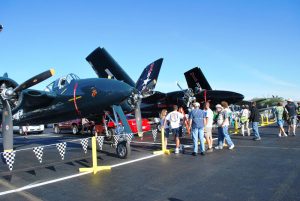
In order to make fans and keep them, they’ve got to have something more to hold onto than an N-number. Many reporters who interview airshow pilots note a confidence, even “swagger” in the way they carry themselves and a smooth, friendly way of speaking that endears people to them. In addition to the fans, it’s important for airshow pilots to be able to win over sponsors. Though the pilot’s skill and experience have a lot to do with it, a great attitude isn’t going to hurt your chances of getting free money or airplane parts.
Skip Stewart, as reported by Air & Space Magazine1, oozes charm and loves to interact with his fans. “After his performance, Stewart lands and taxis before the crowd line, smiling and waving. He’s eating up the applause. He parks, shuts down the engine and leaps out to meet his fans. He loves giving his autograph and handing out pictures of himself with his airplane. And he loves talking, especially about his act, his airplane, and himself.”
When asked by Phil Scott, the reporter behind the article, asked if Skip admits to having a big ego, Skip responded, “Yes. There are no selfless acts, except maybe throwing yourself on a grenade. If you didn’t like the attention, just fly solo in your practice box.”
Love of the Spotlight and Showmanship
A big part of airshows is… putting on a show for the audience. Some people are natural performers, and some have the charisma but not the stage presence, and I’m sure there are some famous airshow pilots who have none of those traits, but I haven’t heard of them. Skip Stewart, an up-and-coming airshow pilot recently interviewed by Air & Space Magazine, says that Sean Tucker, one of the living legends of flight, is “the definition of showmanship. He has this choreography, the whole sequence, that flows.“1
Sometimes, the trick is not doing the same thing but better, but trying out a completely different and unique routine, cultivating a style that’s your own. Mike Goulian3 is known for his aggressive maneuvering, Anna Serbinenko4 (Canadian airshow pilot) has a unique, slower 8KCAB Super Decathlon routine flown to classical music, Greg Shelton flies a warbird with his daughter as his Wing Walker, Mike Younkin flies slow aerobatic maneuvers in a Twin Beech 18 and countless more.
Perseverance and Work Ethic
“I like to think that I bring the fans’ dreams of flying into the plane with me and there’s nowhere I’d rather be than in the cockpit. That’s why I train so hard to keep a finely tuned edge.” Sean Tucker
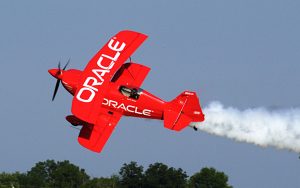
As both Mike Goulian and Patty Wagstaff have described, it takes years of work to get noticed in the airshow world, and the work never stops. Sean Tucker, who has already made “living legend” status, works tirelessly to keep himself- physically, mentally, and technique-wise, in perfect condition. According to his biography on Team Oracle’s website8, “He practices his airshow routine three times every day. To endure the extreme physical demands of each routine, Sean maintains a rigorous physical training schedule, working out more than 340 days per year.”
Starting Out as An Airshow Pilot
“There is simply no easy way to get to the top except for old fashioned blood, sweat, and tears.” Mike Goulian3
Music and Composing Your Routine
Once you’ve gotten all appropriate certificates, endorsements, ratings, and signed up for all your memberships, it’s time to start practicing. (Make sure all practice maneuvers are completed over 1,500 AGL!) Start by moving from one maneuver to another to gauge the speed, altitude, and attitude needed for a smooth and appealing transition, before trying to create an entire routine. It will help the transitions look good to the audience, and help you feel confident behind the yoke. Typically, routines last for two or three songs and expect it to be shorter when you’re just starting out, especially if there are acts following yours. That being said, music is key. Music gets the audience hyped, and helps you remain on-point and on-time with your routine. The synchronization of aerobatic maneuvers and music of an appropriately exciting (or graceful) tone, appeals to everyone, so try your best to remain in time with the beat!
Aerobatic Competency Evaluation and Low Altitude Flying
After you’ve gotten a few airshows under your belt and you feel ready to compete, it’s time to get ACE’d (Aerobatic Competency Evaluation). Your qualified ACE gives you a low altitude competency card, which will allow you to lower the floor of your “box” (performing space) below that 1,500 AGL requirement(IAC). It’s a progressive evaluation, so the more airshows you do and skills you gain, the lower you can fly. Generally, starting out, hopeful competitive aerobatic pilots will be granted a floor of 800 AGL and will proceed as their ACE sees fit all the way down to ground level as they perform at a certain number of airshows without incident.7
Aerobatic Competitions6
When you’ve earned your low altitude competency card, it’s time to compete! Competitions can not only earn you money but catch the eye of sponsors and fans of the sport. Somewhat similar to gymnastics or the Olympic high dive, there are lots of rules and deductions competitors have to be aware of. Each flight performance is graded by a team of judges.
The Judges
The judges are given a paper version of the aerobatic maneuvers, “figures,” you will be flying (starting out, there’s no free-styling or custom routines), written out in Aresti notation. In addition to the graphic representation of the maneuver, each move is assigned a K factor, which is a number that represents how hard it is to fly. The judges then grade each figure on factors such as precision, roundness of loops, symmetry, etc., and multiply the score of each figure (0-10) by the K factor to get the total score for that figure. It’s then run through a computer program which is supposed to account for judge bias or inconsistency (IAC “Official Contest Rules”). In addition to earning points, you can lose points for leaving your “box” (which is watched like hawks from judges on the ground), among other things.
The next part is simple (well, as simple as anything in competitive aerobatics can be): whoever has the best score wins!
As you continue to improve, and hopefully win some competitions, you can move up in category- offering better prizes, more visibility, a greater challenge, and fiercer competition. Eventually, you can earn a spot on the US National Aerobatic Team (IAC) and compete and travel worldwide.
Aerobatics Categories
There are five different categories of airshow pilots broken down based on experience and skill level. As stated on the International Aerobatic Club website6, those categories are as follows:
Primary
Each pilot in the primary category flies the same routine, which is published prior to the contest season.
Sportsman
In the Sportsman category, airshow pilots are required to fly a routine published before the contest season at least three times but are allowed to choreograph their own routine for two flights (subject to certain restrictions).
Intermediate
The Intermediate category is where the IAC starts to turn up the heat. In addition to a more difficult routine (published before the season), they must also fly a routine which is distributed to competitors only a few hours before the flight and cannot be practiced, truly testing how well they know their stuff. They also get a chance to choreograph a routine of their own (also subject to certain restrictions).
Advanced
Pilots competing in the Advanced category do everything the Intermediate category pilots do, but harder. The best of the lot gets the chance to fly on the US Advanced Aerobatic Team, which competes twice a year in international aerobatic competitions.
Unlimited
Unlimited-category pilots fly the hardest routines out there in “an extremely high-performance aircraft,” and get to perform in a four-minute Freestyle Program which demonstrates both the on-the-spot skill and artistic creativity of the pilot before a crowd of spectators. The top-ranked Unlimited category pilots can qualify to be on the US Unlimited Aerobatic Team which also competes twice a year in international aerobatic competitions.
The Pitts Special remains the quintessential aerobatic performer, especially in the eyes of the general public.
Mention aerobatics and air shows to almost anyone and the first image that comes to mind is usually a small, brightly-painted biplane—the Pitts Special. [Read More]
Professional Airshow Pilots on Finding Sponsors
Mike Goulian explains finding sponsors like this: “From my experience, the sponsors come last. First, you need to show courage and determination by becoming a winning aviator. Second, your flying and your attitude must be mature enough to handle the privilege and responsibility that comes with flying the colors of a company. I took my first aerobatic lesson in 1985 and ‘signed on’ with my first title sponsor in 2004. To me, the 19-year-wait was worth it!“3
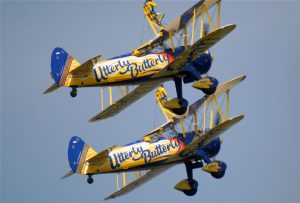
First off, I think it’s important to clarify that sponsors (99.9% of the time) aren’t going to pay you enough to live on, especially starting out. At best, you can find sponsors who will give you discounts on their merchandise (engines, parachutes, sunglasses even) or free stuff, but don’t expect a hefty paycheck.
As you get better and more widely known, bigger sponsors will step up and become interested in you. But until then, the work is on you. Once you have an impressive portfolio of airshow performances and competition wins, approach sponsors you’re interested and see if you can work something out. Don’t be afraid to aim high, but don’t be surprised when Avemco doesn’t think you’ve earned their sponsorship just yet.
Sean Tucker, the living legend, didn’t land a sponsor that paid him until four years after he returned to airshows (he’d had a crash), but now, he’s got loads of sponsors, including Oracle, the massive tech firm. Apparently, his sponsorships who supply airplane parts and products alone save him about $80,000 a year1.
The Money Issue
Saving $80,000 a year on your airplane and all its expenses is a pretty big deal when it’s not unusual to spend $100,000 or more “a year for several years before any sort of financial return.” According to the IAC, that staggering amount of money includes the cost of “owning, storing, fueling, insuring, and maintaining a personal aircraft, as well as the cost of traveling and training.”6
“To get to the top ranks of World Aerobatic Competition or air show flying, you’re looking at approximately ten years of practice and training. To be in the [Red Bull Air Race], you have to become an aerobatic champion first.” Mike Goulian3
Most airshows only have a few pilots on the docket at once, so proving yourself is difficult, and even once you get hired at one, the pay (starting out at least) isn’t too thrilling. Generally, an airshow pilot will make between $500 or so a show, and only fly a few shows a year, but once people start recognizing your name, that figure can jump up pretty quick. According to the Air & Space Magazine’s interview with Skip Stewart, his climb to financial stability went a little something like this: “In 2002, Stewart flew seven shows, asking $1,500 a pop. The next year, he flew 10 shows for $2,000 each, then last year he received $2,950 per show for 10 shows. For this season, he’s hiking his price to $4,900. Not that he’s carved that fee in stone; it’s just what he thinks someone at his level should make.“1

The interviewer goes on to clarify that even if Skip flies “eight or so shows this season at $4,900 apiece, his earnings won’t cover his expenses. He easily spends his whole take on maintaining and rebuilding Prometheus [his Pitts]: It costs him $40,000 a year to fly a single airshow season and $3,600 to insure the Pitts.“1
Mike Goulian is one of the many airshow pilots who had to bury himself in debt on his way to the top. In the article on his website, “I Want to Do What You Do,” about becoming an airshow pilot, he says,
“Money helps, but it’s not vital. Many people have made it in the sport by working like crazy at night while flying acro during the day. It’s a longer road, but one worth traveling. That reminds me of the winter of 1995 when I ran out of money and my parents couldn’t afford to help me make the bank payments on my EXTRA 300S. There was only one thing left to do…. put the payments on my credit card. I was not going to let a lack of money keep me from my dreams. So I built up about 20K worth of credit card debt over the next six months. That September I won the US Nationals and started making money flying air shows. After about a year, I had paid off my debt. Those are the kinds of tests that one will be faced with along the way. As the saying goes, ‘if it were easy, everyone would do it.‘”3
Final Thoughts on Becoming an Airshow Pilot
As you have no doubt figured out by now, after reading the challenges of becoming a professional airshow pilot, the competition is fierce and the space at the top is limited. If you’re interested in flying local airshows in the summer for fun or a little bit of spending money, it’s a different story, but it’s still a tough game to get into. Even if all goes according to plan and you have the money and the time, you’re still risking life and limb whenever you go up in the air to try a new maneuver or even perfect an older one that’s performed close to the ground.
However, if you have the passion and the dedication to flying and “making it” as an airshow pilot, there are few (if any) aviation careers that are more exciting or fulfilling. If you ask the pilots who had what it takes to achieve their dreams of flying the Red Bull Air Races or becoming a US Aerobatic Champion, I’m sure any of them would say they’d do it all again.
Featured image by Jim Hoddenbach, pilot/photographer/mechanic/aviator extraordinaire.
Sources and References:
1 – “So You Want to Be an Airshow Pilot,” Phil Scott, Air & Space Magazine, Retrieved 4-6-17
2 – “What It Takes to Be a Top Airshow Pilot,” Grant Opperman, Flying Magazine, Retrieved 4-6-17
3 – “I Want to Do What You Do,” Mike Goulian, Retrieved 4-6-17
4 – “The Life of an Airshow Pilot,” Patty Wagstaff, Plane & Pilot Magazine, Retrieved 4-6-17
5 – Basic Aerobatic Course Outline, Aerobatic Company and Flight School, Retrieved 4-6-17
6 – Competition Aerobatics, International Aerobatic Club, Retrieved 4-6-17
7 – Ace Program, International Council of Airshows, Retrieved 4-6-17
8 – About Sean D. Tucker, Team Oracle, Retrieved 4-6-17
 Preventing Loss of Control In Flight
Preventing Loss of Control In Flight
A few years ago, the FAA emphasized “Runway Incursions.” There was rarely a flight magazine that did not have something to say about runway incursions. Luckily that seems to have been properly addressed. Now comes the new FAA, NTSB, IAC and EAA emphasis, “Loss of Control.” Over the next few years, you will be hearing lots about “Loss of Control.” This article will begin that discussion. [Read More]









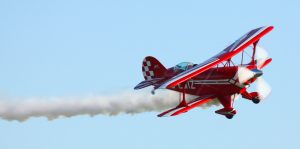




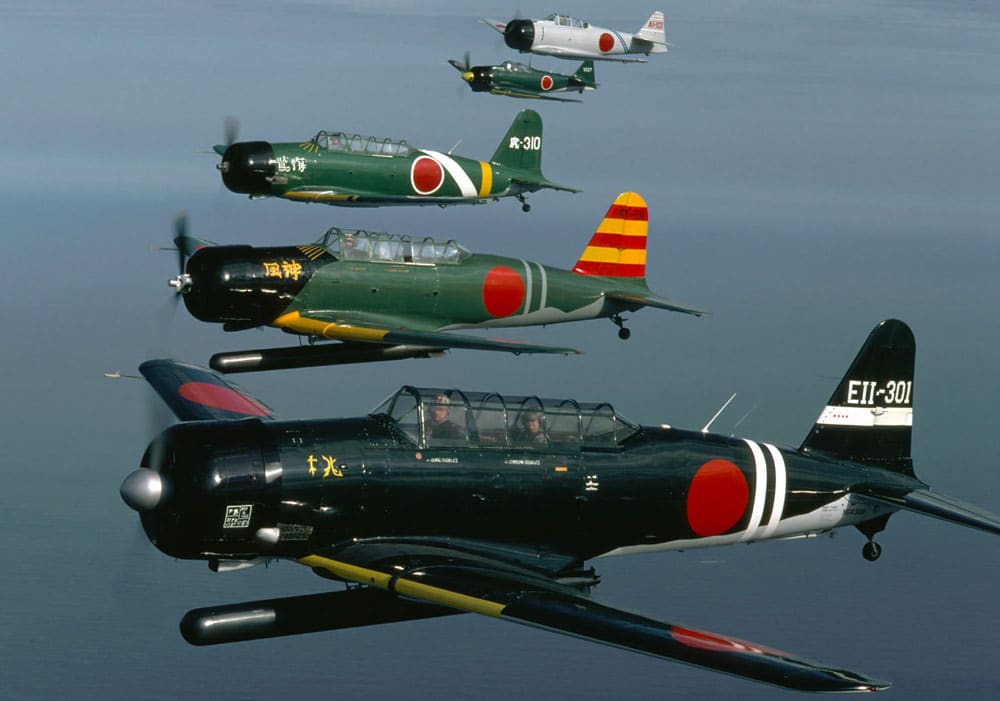

But how do you even get started when you are poor with a mountain of debt to begin with from school? The problem with Aviation is the cost. I fly as much as I can but can never even come close to affording my own aircraft. As a former USAF pilot I know I have what it takes but yet cost holds me back every single time…